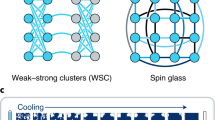Abstract
The research considers the minimization of spin glass energy via learning and evolution. The Sherrington-Kirkpatrick spin-glass model is used. A population of autonomous agents is considered. The genotype and phenotype of each agent are chains consisting of a great number of spins. The energy of spin glasses is minimized through learning and evolution of agents. The genotypes of agents are optimized by evolution; the phenotypes are optimized by learning. The evolution of a population of agents is analyzed. In the evolution the fitness of agents is determined by the energy of the spin glass of final phenotypes resulted from learning: the lower the energy is, the higher the fitness of the agent is. In the next generation agents are selected with probabilities corresponding to their fitnesses. Agents-descendants get mutationally modified genotypes of agents-ancestors. The interaction between learning and evolution during the spin glass energy minimization is investigated. The research involves the computer simulation.












Similar content being viewed by others
REFERENCES
Sherrington, D. and Kirkpatrick, S., Solvable model of spin-glass, Phys. Rev. Lett., 1975, vol. 35, no. 26, pp. 1792–1796.
Kirkpatrick, S. and Sherrington, D., Infinite range model of spin-glass, Phys. Rev. B, 1978, vol. 17, no. 11, pp. 4384–4403.
Red’ko, V.G., Mechanisms of interaction between learning and evolution, Biol. Inspired Cognit. Arch., 2017, vol. 22, pp. 95–103.
Red’ko, V.G., Modelirovanie kognitivnoi evolyutsii: na puto k teorii evolyutsionnogo proiskhozhdeniya myshleniya (Modeling of Cognitive Evolution: Towards the Theory of Evolutionary Origin of Human Thinking), Moscow: URSS/Lenand, 2018.
Red’ko, V.G., Model of interaction between learning and evolution, 2014, ar**v:1411.5053.
Tanaka, F. and Edwards, S.F., Analytic theory of the ground state properties of a spin glass. I. Ising spin glass, J. Phys. F: Met. Phys., 1980, vol. 10, no. 12, pp. 2769–2778.
Young, A.P. and Kirkpatrick, S., Low-temperature behavior of the infinite-range Ising spin-glass: exact statistical mechanics for small samples, Phys. Rev. B, 1982, vol. 25, no. 1, pp. 440–451.
Red’ko, V.G., Spin glasses and evolution, Biofizika, (Moscow), 1990, vol. 35, no. 5, pp. 831–834.
Adaptive IndividualsInEvolving Populations: Models And Algorithms, Belew, R.K. and Mitchell, M., Eds., Reading, MA: Addison-Wesley, 1996.
Evolution, Learning, and Instinct: 100 Years of the Baldwin Effect, Turney, P., Whitley, D., and Anderson, R., Eds., Cambridge, MA: MIT Press, 1996.
Hinton, G.E. and Nowlan, S.J., How learning can guide evolution, Complex Syst., 1987, vol. 1, no. 3, pp. 495–502.
Mayley, G., Guiding or hiding: explorations into the effects of learning on the rate of evolution, Proc. Fourth European Conf. on Artificial Life (ECAL’97), Husbands, P. and Harvey, I., Eds., Cambridge, MA: MIT Press, 1997, pp. 135–144.
Red’ko, V.G., Neutral evolution game, Principia Cybernetica Web, 1998. http://cleamc11.vub.ac.be/NEUTEG.html. Accessed May 29, 2020.
Kimura, M., The Neutral Theory of Molecular Evolution, Cambridge: Cambridge Univ. Press, 1983.
Kryzhanovsky, B. and Malsagov, M., The spectra of local minima in spin-glass models, Opt. Mem. Neural Networks, 2016, vol. 25, no. 1, pp. 1–15.
Kryzhanovsky, B. and Litinskii, L., Generalized approach to description of energy distribution of spin system, Opt. Mem. Neural Networks, 2015, vol. 24, no. 3, pp. 165–185.
Karandashev, I. and Kryzhanovsky, B., Matrix transformation method in quadratic binary optimization, Opt. Mem. Neural Networks, 2015, vol. 24, no. 2, pp. 67–81.
Karandashev, I. and Kryzhanovsky, B., Attraction area of minima in quadratic binary optimization, Opt. Mem. Neural Networks, 2014, vol. 23, no. 2, pp. 84–88.
Karandashev, I. and Kryzhanovsky, B., Global minimum depth in Edwards-Anderson model, Proc. 20th Int. Conf. on Engineering Applications of Neural Networks, EANN-2019, New York: Springer-Verlag, 2019, pp. 391–398.
Karandashev, I.M. and Kryzhanovsky, B.V., Increasing the attraction area of the global minimum in the binary optimization problem, J. Global Minimization, 2013, vol. 56, no. 3, pp. 1167–1185.
ACKNOWLEDGMENTS
The author thanks Ya.M. Karandashev, B.V. Kryzhanovsky, and M.Yu. Malsagov for their valuable comments and discussions.
Funding
The work was financially supported by State Program of SRISA RAS. Project no. 0065-2019-0003 (AAA-A19-119011590090-2).
Author information
Authors and Affiliations
Corresponding author
Ethics declarations
The authors declare that they have no conflicts of interest.
About this article
Cite this article
Red’ko, V.G. Spin Glass Energy Minimization through Learning and Evolution. Opt. Mem. Neural Networks 29, 187–197 (2020). https://doi.org/10.3103/S1060992X20030054
Received:
Revised:
Accepted:
Published:
Issue Date:
DOI: https://doi.org/10.3103/S1060992X20030054




